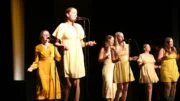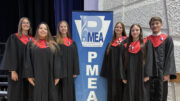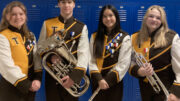AUSTIN, Texas (AP) — Virtual reality is big at South by Southwest Interactive, the annual Austin, Texas, tech festival that wraps up Tuesday. It’s a big technological development, a business opportunity — and also just a big experiment, as everyone tries to figure out how to use it.
All around Austin, companies like Samsung, Google, The New York Times and even McDonald’s were showing off their virtual reality efforts. Because it basically immerses viewers in an artificial world, VR can reach an audience in more direct and fundamental ways than other media. Companies and creators are still feeling their way with the new technology.
“Part of what’s so exciting about it is that there are no rules and no best practices, it’s still really unclear what this is for and how best to use it,” said New York Times editor Sam Dolnick. “We’re shaping that at once in real time.”
Facebook’s long-awaited Oculus Rift begins shipping to the public later this month, and new headsets from HTC and Sony are also on their way. (Google even has a VR headset called Cardboard — which is pretty much exactly what it sounds like — for $15.) All that is creating a tidal rush of enthusiasm and hype for the new technology.
The opportunity could be big: Deloitte Global predicts that virtual reality will have its first billion dollar year in 2016, with about $700 million in hardware sales and the remainder from games and other VR “experiences.” It estimates headset sales of 2.5 million units this year.
And audiences appear to find VR especially engaging, at least so far. Take, for instance, 360 degree videos, which are typically shot by multicamera setups that capture images in every direction. Viewers can then choose to look at anything in their field of view, as if they were standing where the camera is.
People are 7.5 times more likely to share such videos compared to fixed-frame video, VR journalist Sarah Hill said during a packed SXSW panel discussion on VR storytelling.
At the moment, it’s a challenge to walk around Austin without stumbling across a VR presentation. The New York Times took over the Easy Tiger bar on Austin’s main drag, 6th Street, to host panels and parties that promoted its VR efforts. It provided swivel chairs and headsets for people to watch its virtual reality projects, including “The Displaced,” a 10 minute piece in which viewers follow three child refugees in different nations through their daily lives.
Google threw a VR party to showcase its Tilt Brush 3D VR painting app. At its Google Fiber Space in Austin, animator Chris Prynoski created a painting wearing a VR headset while the image itself appeared on a large screen above him. And there was a 360 degree photo booth, where party goers created 360 images of themselves viewable via Google’s Cardboard headset.
Samsung’s showcase used moving chairs and Gear VR headsets to let festival goers take a bumpy VR ride on a roller coaster via a video it developed with Six Flags. The company also brought virtual reality headsets for festival goers to try out, assuming they were willing to tweet the hashtag “VRondemand” and then send Samsung their location.
At McDonald’s Loft near the Austin Convention Center, the fast-food giant offered festival goers snacks, live music, and VR. Specifically, that is, the chance to use an HTC Vive and its controllers, due out later this year, to paint a colorful mural on a Happy Meal box and throw paintballs in a virtual world. “It’s an emerging technology that has interesting potential applications,” said DeLu Jackson, a McDonald’s vice president of global digital engagement.
Gary Banks, executive producer at digital content studio Groove Jones in Dallas, created the VR game for McDonald’s and says interest in VR has jumped over the past year. “It’s not mainstream yet, so there’s the coolness factor and cachet that brands want to attach to themselves,” Banks said.
Still, creating virtual reality pieces remains rife with challenges. Andrey Doronichev, a product manager for VR apps at Google, said one of them simply involves teaching audiences what to expect from VR pieces. Would-be creators of VR pieces need better tools, too.
The industry also needs new ways to measure how people interact with VR videos. The common metric of “views” may not suffice, particularly if people watch fewer VR videos but spend more time with them, said Mehrshad Mansouri, director of business development for GoPro. But he added that it wasn’t clear what should replace views.
“We don’t have an answer yet, but the current model needs improvement,” he said.







































